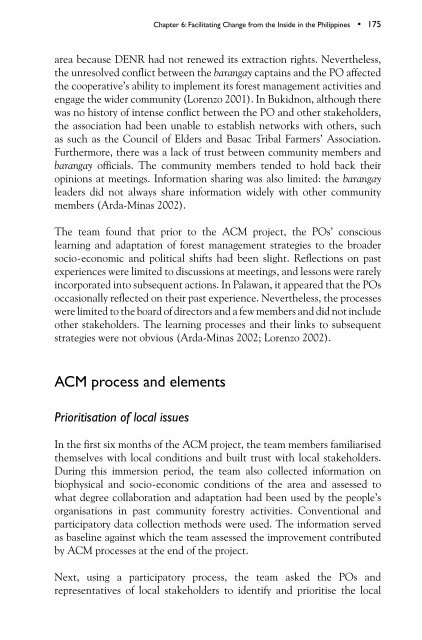Adaptive collaborative management of community forests in Asia ...
Adaptive collaborative management of community forests in Asia ...
Adaptive collaborative management of community forests in Asia ...
You also want an ePaper? Increase the reach of your titles
YUMPU automatically turns print PDFs into web optimized ePapers that Google loves.
Chapter 6: Facilitat<strong>in</strong>g Change from the Inside <strong>in</strong> the Philipp<strong>in</strong>es • 175<br />
area because DENR had not renewed its extraction rights. Nevertheless,<br />
the unresolved conflict between the barangay capta<strong>in</strong>s and the PO affected<br />
the cooperative’s ability to implement its forest <strong>management</strong> activities and<br />
engage the wider <strong>community</strong> (Lorenzo 2001). In Bukidnon, although there<br />
was no history <strong>of</strong> <strong>in</strong>tense conflict between the PO and other stakeholders,<br />
the association had been unable to establish networks with others, such<br />
as such as the Council <strong>of</strong> Elders and Basac Tribal Farmers’ Association.<br />
Furthermore, there was a lack <strong>of</strong> trust between <strong>community</strong> members and<br />
barangay <strong>of</strong>ficials. The <strong>community</strong> members tended to hold back their<br />
op<strong>in</strong>ions at meet<strong>in</strong>gs. Information shar<strong>in</strong>g was also limited: the barangay<br />
leaders did not always share <strong>in</strong>formation widely with other <strong>community</strong><br />
members (Arda-M<strong>in</strong>as 2002).<br />
The team found that prior to the ACM project, the POs’ conscious<br />
learn<strong>in</strong>g and adaptation <strong>of</strong> forest <strong>management</strong> strategies to the broader<br />
socio-economic and political shifts had been slight. Reflections on past<br />
experiences were limited to discussions at meet<strong>in</strong>gs, and lessons were rarely<br />
<strong>in</strong>corporated <strong>in</strong>to subsequent actions. In Palawan, it appeared that the POs<br />
occasionally reflected on their past experience. Nevertheless, the processes<br />
were limited to the board <strong>of</strong> directors and a few members and did not <strong>in</strong>clude<br />
other stakeholders. The learn<strong>in</strong>g processes and their l<strong>in</strong>ks to subsequent<br />
strategies were not obvious (Arda-M<strong>in</strong>as 2002; Lorenzo 2002).<br />
ACM process and elements<br />
Prioritisation <strong>of</strong> local issues<br />
In the first six months <strong>of</strong> the ACM project, the team members familiarised<br />
themselves with local conditions and built trust with local stakeholders.<br />
Dur<strong>in</strong>g this immersion period, the team also collected <strong>in</strong>formation on<br />
biophysical and socio-economic conditions <strong>of</strong> the area and assessed to<br />
what degree collaboration and adaptation had been used by the people’s<br />
organisations <strong>in</strong> past <strong>community</strong> forestry activities. Conventional and<br />
participatory data collection methods were used. The <strong>in</strong>formation served<br />
as basel<strong>in</strong>e aga<strong>in</strong>st which the team assessed the improvement contributed<br />
by ACM processes at the end <strong>of</strong> the project.<br />
Next, us<strong>in</strong>g a participatory process, the team asked the POs and<br />
representatives <strong>of</strong> local stakeholders to identify and prioritise the local
















